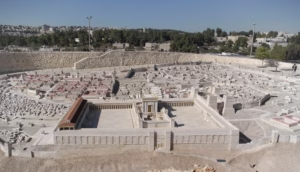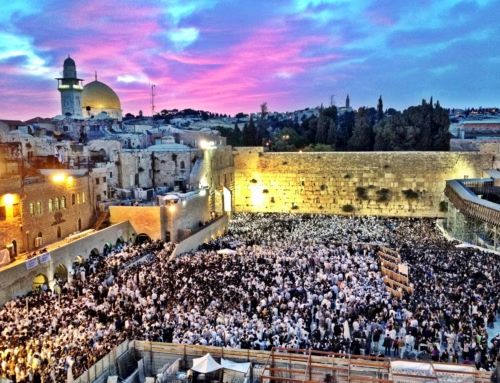Jesus, the Temple and Jerusalem
This December, the Christmas holiday coincided with the Jewish holiday of Hanukkah, the temple dedication festival. While Christians at this time of year celebrate Christmas to commemorate the birth of Jesus, Jesus himself participated in the celebration of the Jewish holiday of Chanukkah, which is held to commemorate the rededication of the temple in 165 BC after it was desecrated by Antiochus IV Epiphanes’ pagan altar of Zeus

A model of Herod’s Temple, now in the Israel Museum in Jerusalem. East is at the bottom of the picture. Photo: Berthold Werner
The Gospel of John (10:22) describes how Jesus walked around in Solomon’s Colonnade in the temple during the festival of the temple dedication in Jerusalem, where he confirmed to those around him that he was the Messiah.
Jesus had a close relationship with the temple from an early age. Luke 2 describes how Joseph and Mary brought the newborn Jesus to the temple to fulfil the law of Moses.
His upbringing was thereafter characterized by regular visits to the temple in Jerusalem. Luke’s Gospel tells how Jesus’ parents used to go up to Jerusalem every year for the Passover. Since these visits to the temple also took place during the two other pilgrimage festivals of Shavuot (Pentecost) and Sukkot (Feast of Tabernacles), Jesus had perhaps already visited the temple about thirty times when he visited Jerusalem at the age of twelve in connection with the Passover. There he remained in the temple without his parents’ knowledge when they returned home.
In the temple he sat in the midst of the teachers, listening to them and asking questions. All who heard him were amazed at his understanding and his answers. When his parents asked why he had stayed behind and troubled them, he answered “Why did you look for me? Did you not know that I must be in my Father’s house?” (Another translation reads: “about my Father’s business”).
City of the Great King
As early as in the Beatitudes in Matthew 5, Jesus confirms his claim to Jerusalem when he calls it “the city of the great King.” During his early ministry in Galilee, people came from Jerusalem to find out what was happening around him and Jesus soon began preparing his disciples for his journey to Jerusalem where he would be handed over to the Gentiles and put to death.
When he later rode into the city on a donkey, he was met by the city’s inhabitants who shouted the messianic greeting: “Hosanna to the Son of David! Blessed is he who comes in the name of the Lord.”
As Jesus approached the city and saw Jerusalem, he wept over it as he foresaw its destruction.
Jesus then purified the temple and identified himself with the biblical prophets who confronted the political and religious leadership of Israel when he said “Jerusalem, Jerusalem, you who kill the prophets and stone those sent to you! How often I have longed to gather your children together, as a hen gathers her chicks under her wings, but you were not willing” (Luke 14:34).
During this period, Jesus taught every day in the temple.
Coming again to Jerusalem
On several occasions towards the end of his life, Jesus spoke of his return to Jerusalem. In Matthew 23:39, Jesus promised the inhabitants of Jerusalem that they would see him again when they shouted aloud, “Blessed is he who comes in the name of the Lord.” And he declared to the chief priests and Sanhedrin (Matthew 26:64), “Hereafter you will see the Son of Man sitting at the right hand of Power and coming on the clouds of heaven.”
Moments after Jesus’ ascension, two men in white robes stood among the anxious disciples and said, “This same Jesus, who was taken up from you into heaven, will come in the same way as you have seen him go into heaven.”
Besides that, Jesus had previously urged the disciples not to leave Jerusalem, but wait there until the promise that they would be filled with the Holy Spirit was fulfilled. After His’ ascension, the disciples were “constantly in the temple, praising God”, states the last verse of Luke’s Gospel. The temple clearly remained central even after Pentecost and it was there that the believers gathered faithfully and unitedly daily. “Every day in the temple and from house to house they continued teaching and proclaiming the gospel that Jesus is the Messiah,” writes Luke in Acts 5.


